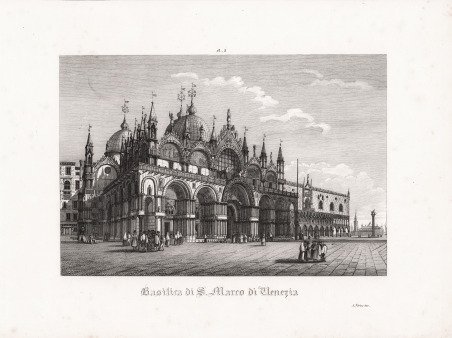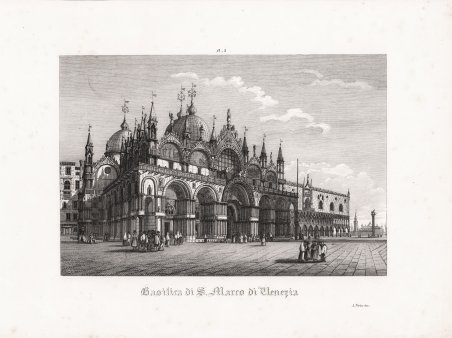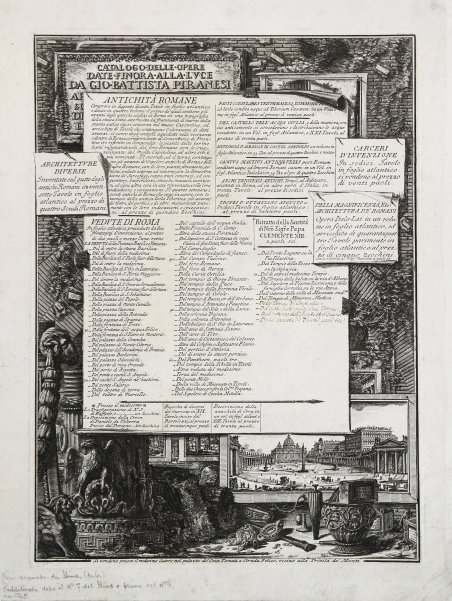Acquaforte e bulino, circa 1767, firmata in lastra in alto a sinistra. Esemplare corrispondente all’undicesimo stato di trentasei descritto dal recentissimo saggio di Andrew Robison (marzo 2022) databile al 1767. Rispetto al precedente stato del Catalogo, troviamo la presenza, tra le Vedute di Roma – ora 74 - della veduta Del Tempio di Minerva Medica che venne realizzata alla fine del 1766. Tuttavia, l’addenda manoscritta, autografa, di 4 Vedute di Roma colloca questo esemplare tra l’undicesimo e il dodicesimo stato descritti da Robison. Se dal punto di vista della schedatura risulta corrispondere all’undicesimo stato, l’aggiunta manoscritta dell’autore lo rende un aggiornamento di tale tiratura. Magnifica prova, impressa su carta vergata coeva con filigrana “doppio cerchio e giglio”, con margini, tracce di colla al verso, per il resto in buono stato di conservazione. Abitudine comune di molti editori nel diciottesimo secolo era quella di redigere e dare alle stampe cataloghi o listini prezzi delle opere grafiche che offrivano in vendita, allo scopo pubblicitario di promulgarle, facilitarne le ordinazioni, ricevere sottoscrizioni. Il Piranesi non si limitò ad un semplice catalogo scritto, realizzandone uno illustrato, meglio conosciuto come catalogo inciso, che pubblicò per la prima volta nel 1761. L’occasione fu quella della nuova sede di Palazzo Tomati, dove andò a stabilirsi proprio nel 1761. Il primo catalogo conteneva l’elenco delle 59 vedute della serie Vedute di Roma prodotte sino ad allora, comprendendo anche la lista dei libri e delle altre stampe realizzate; tale catalogo venne di volta in volta aggiornato con l’aggiunta del nuovo materiale in vendita, producendo un notevole numero di stati differenti, di cui ben 36 sono ora noti. Il catalogo inciso costituisce un elemento fondamentale per la datazione delle opere del Piranesi, strumento insostituibile di studio e ricerca, la cui analisi degli stati permette di datare approssimativamente tutte le opere tarde dell’artista. Nella realizzazione di questa opera, che a ragione viene considerata come l’ennesimo capolavoro, il Piranesi studia soprattutto l’aspetto decorativo che la stessa doveva assumere. La tecnica usata è la stessa di quella che ritroviamo in alcuni suoi libri; su uno sfondo architettonico egli dà vita ad un effetto trompe oeil, disegnando degli spilli che fermano alcuni cartigli contenenti titoli delle sue opere. Il primo piano è costituito da rovine e frammenti scultorei, mentre lo spazio bianco è volutamente inserito per aggiungere in seguito altre voci. Gli esemplari del catalogo sono notevolmente più rari delle altre incisioni, probabilmente sia per la scarsa tiratura, sia perché considerati effimero materiale pubblicitario, e quindi non conservati. Bibliografia Andrew Robison, Piranesi’s Catalogo delle Opere, in The Burlington Magazine, n. 164 (2022), pp. 230-245, XI/XXXVI; H. Focillon, ' Giovan Battista Piranesi 1720-1778 ' (1918): n. 1; A. M. Hind, ' Giovanni Battista Piranesi. A critical study with a list of his published works and detailed catalogues of the Prisons and Views of Rome ' (1922): p. 6; cfr. K. Meyer-Haunton in ' Piranesi, Incisioni, Rami, Legature, Architetture. Etching and engraving, circa 1767, signed in plate top left. Example of the eleventh state of thirty-six described in Andrew Robison's very recent essay (March 2022) dated 1766. Compared to the previous state of the Catalogo, we find the presence, among the Vedute di Roma - now 74 - of the view of the Del Tempio di Minerva Medica Medica which was made at the end of 1766. However, the handwritten, autograph addenda of 4 Vedute di Roma places this example between the eleventh and twelfth state described by Robison. If from a filing point of view it corresponds to the eleventh state, the author's handwritten addenda makes it an update of that issue. A very good impression, printed on laid paper with “double encircled fleur de lys” watermark, with margins, trace of glue on the back, otherwise in good condition. A common custom among many editors in the eighteenth century was to compile and print catalogues or price lists of the graphic works they sold with the promotional intent of advertising them, uphold orders and obtain subscriptions. Piranesi did not limit himself to a common written catalogue but even published an illustrated one, better known as the engraved catalogue, which he issued for the first time in 1761. This happened in the circumstance of his moving to new premises at the Tomati Palace. The first catalogue included the list of the fifty-nine views belonging to the collection Vedute di Roma, which he had created up to then, together with an inventory of other published books that featured his prints. This catalogue was constantly updated by adding new items that were put on sale, giving rise to a number of different states, of which 36 are currently known. The engraved catalogue is of primary importance for the dating of Piranesi's works, an essential means of study and research as the analysis of its states allows the approximate chronological classification of all of the artist's later works. When creating this work, which is correctly considered as another of his masterpieces, Piranesi focused his studies on its decorative aspects. He used the same technique that can be found in some of his books, creating a trompe-l'oeil effect on an architectural background, depicting pins which seemed to fasten a number of cartouches with titles pertaining to his works. The foreground consisted of ruins and sculptural fragments while an additional white space was included on purpose to allow for the addition of new items in the future. The items included in this catalogue are considerably rarer than Piranesi's other engraving, probably because they were printed in a smaller number, as well as for the reason that they were considered as short-lived promotional material, and therefore were not preserved. Some of these bear dedications to the artist's friends and benefactors, while, on other ones, pen-written notes enumerating the latest items, often by the artist's own hand, can be seen. Extremely rare example of the Piranesi’s Catalogo delle Opere. Bibliografia Andrew Robison, Piranesi’s Catalogo delle Opere, in The Burlington Magazine, n. 164 (2022), pp. 230-245, XI/XXXVI; H. Focillon, ' Giovan Battista Piranesi 1720-1778 ' (1918): n. 1; A. M. Hind, ' Giovanni Battista Piranesi. A critical study with a list of his published works and detailed catalogues of the Prisons and Views of Rome ' (1922): p. 6; cf. K. Meyer-Haunton in ' Piranesi, Incisioni, Rami, Legature, Architetture. Cfr.



Descubre cómo utilizar
Descubre cómo utilizar

